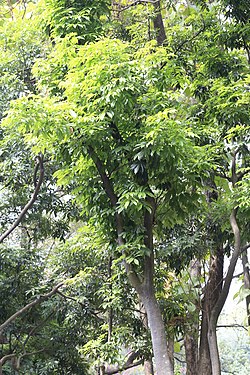
Summary
Ormosieae es una tribu de plantas de la familia Fabaceae. Sus miembros se encuentran, sobre todo, en regiones tropicales del continente americano, además del sudeste asiático y norte de Australia.[2][4] Los miembros de esta tribu se incluían anteriormente en Sophoreae,[5] [6] pero se han trasladado a otra circunscripción taxonómica.[1] [2] Consecuentemente, esta tribu forma un clado monofilético basado en los análisis de filogenética molecular.[2] [7][8][9] [10][11][12]
| Ormosieae | ||
|---|---|---|
 Ormosia pinnata | ||
| Taxonomía | ||
| Reino: | Plantae | |
| División: | Magnoliophyta | |
| Clase: | Magnoliopsida | |
| Orden: | Fabales | |
| Familia: | Fabaceae | |
| Subfamilia: | Faboideae | |
| Tribu: |
Ormosieae (Yakovlev, 1991) Cardoso et al. 2013[1][2][3] | |
| Géneros | ||
Clathrotropis (Benth.) Harms | ||
| Sinonimia | ||
Clado Ormosia Cardoso et al. 2012[1] | ||
La tribu no cuenta con definición de nodo base, aunque se han identificado provisionalmente sinapomorfias morfológicas: "vainas regularmente dehiscentes con valvas leñosas". Al igual que otras genistoideas, los miembros de Ormosieae son productores del alcaloide quinolizidina.[13]
Referencias
editar- ↑ a b c Cardoso D, de Queiroz LP, Pennington RT, de Lima HC, Fonty É, Wojciechowski MF, Lavin M. (2012). «Revisiting the phylogeny of papilionoid legumes: new insights from comprehensively sampled early-branching lineages». Am J Bot 99 (12): 1991-2013. doi:10.3732/ajb.1200380. Archivado desde el original el 28 de agosto de 2017. Consultado el 9 de enero de 2015.
- ↑ a b c d Cardoso D, Pennington RT, de Queiroz LP, Boatwright JS, Van Wyk B-E, Wojciechowski MF, Lavin M. (2013). «Reconstructing the deep-branching relationships of the papilionoid legumes». S Afr J Bot 89: 58-75. doi:10.1016/j.sajb.2013.05.001.
- ↑ Wojciechowski MF. (2013). «Towards a new classification of Leguminosae: Naming clades using non-Linnaean phylogenetic nomenclature». S Afr J Bot 89: 85-93. doi:10.1016/j.sajb.2013.06.017.
- ↑ Pennington RT, Stirton CH, Schrire BD. (2005). «Tribe Sophoreae». En Lewis G, Schrire B, Mackinder B, Lock M, ed. Legumes of the World. Royal Botanic Gardens, Kew. pp. 227-249. ISBN 1900347806. Archivado desde el original el 2 de febrero de 2014. Consultado el 9 de enero de 2015.
- ↑ Polhill RM. (1981). «Sophoreae». En Polhill RM, Raven PH, ed. Advances in Legume Systematics, Parts 1 and 2. Royal Botanic Gardens, Kew. pp. 213-230. ISBN 9780855212247. Archivado desde el original el 3 de diciembre de 2013. Consultado el 9 de enero de 2015.
- ↑ Polhill RM. (1981). «Sophoreae». En Polhill RM, Raven PH, ed. Advances in Legume Systematics, Parts 1 and 2. Royal Botanic Gardens, Kew. pp. 213-230. ISBN 9780855212247. Archivado desde el original el 3 de diciembre de 2013. Consultado el 9 de enero de 2015.
- ↑ Wojciechowski MF, Lavin M, Sanderson MJ. (2004). «A phylogeny of legumes (Leguminosae) based on analysis of the plastid matK gene resolves many well-supported subclades within the family». Am J Bot 91 (11): 1846-1862. PMID 21652332. doi:10.3732/ajb.91.11.1846. Archivado desde el original el 3 de enero de 2017. Consultado el 9 de enero de 2015.
- ↑ Pennington RT, Lavin M, Ireland H, Klitgaard B, Preston J, Hu J-M. (2001). «Phylogenetic relationships of basal papilionoid legumes based upon sequences of the chloroplast trnL intron». Syst Bot 55 (5): 818-836. doi:10.1043/0363-6445-26.3.537.
- ↑ Lavin M, Herendeen PS, Wojciechowski MF. (2005). «Evolutionary rates analysis of Leguminosae implicates a rapid diversification of lineages during the tertiary». Syst Biol 54 (4): 575-94. PMID 16085576. doi:10.1080/10635150590947131.
- ↑ LPWG [Legume Phylogeny Working Group] (2013). «Legume phylogeny and classification in the 21st century: progress, prospects and lessons for other species-rich clades». Taxon 62 (2): 217-248. doi:10.12705/622.8.
- ↑ Doyle JJ, Doyle JL, Ballenger JA, Palmer JD. (1996). «The distribution and phylogenetic significance of a 50-Kb chloroplast DNA inversion in the flowering plant family Leguminosae». Filogenética molecular y evolución 5 (2): 429-438. PMID 8728401. doi:10.1006/mpev.1996.0038.
- ↑ Doyle JJ, Doyle JL, Ballenger JA, Dickson EE, Kajita T, Ohashi H. (1997). «A phylogeny of the chloroplast gene rbcL in the Leguminosae: taxonomic correlations and insights into the evolution of nodulation». Am J Bot 84 (4): 541-554. PMID 21708606. doi:10.2307/2446030.
- ↑ Kinghorn AD, Hussain RA, Robbins EF, Balandrin MF, Stirton CH, Evans SV. (1988). «Alkaloid distribution in seeds of Ormosia, Pericopsis and Haplormosia». Fitoquímica 27 (2): 439-444. doi:10.1016/0031-9422(88)83116-9.


